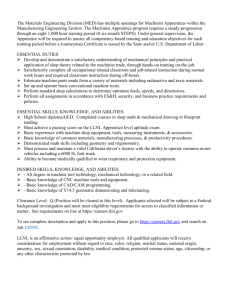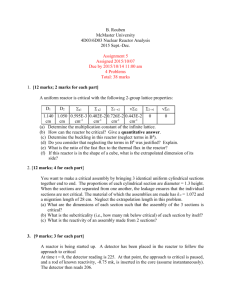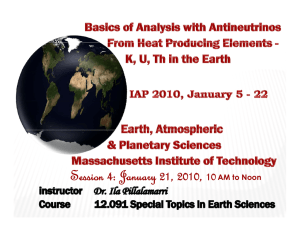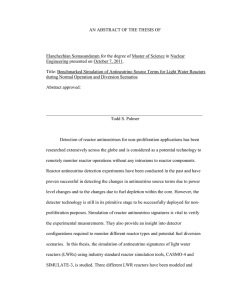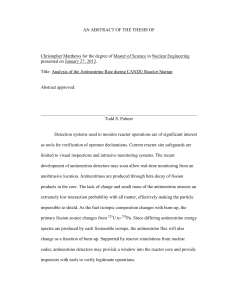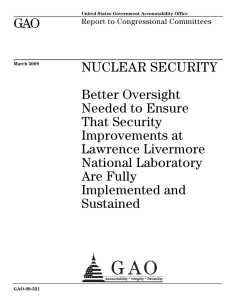Bernstein_SafeguardIssues - e
advertisement
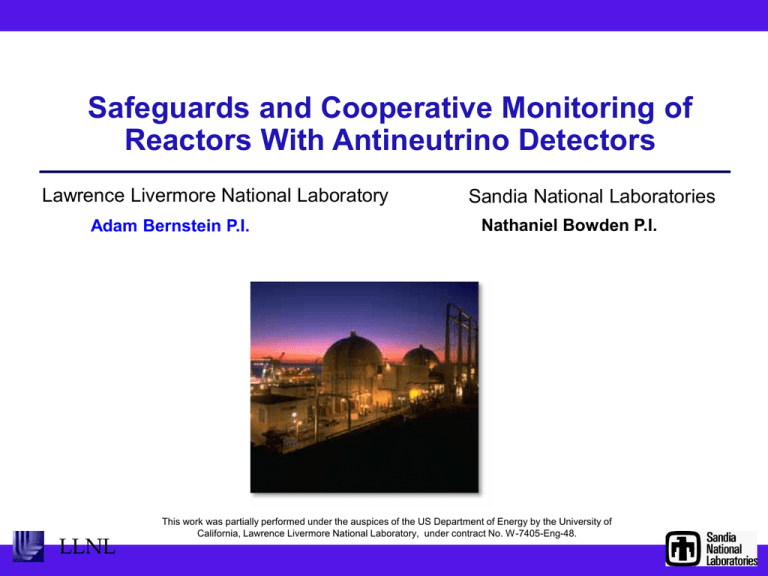
Safeguards and Cooperative Monitoring of Reactors With Antineutrino Detectors Lawrence Livermore National Laboratory Adam Bernstein P.I. LLNL Sandia National Laboratories Nathaniel Bowden P.I. This work was partially performed under the auspices of the US Department of Energy by the University of California, Lawrence Livermore National Laboratory, under contract No. W-7405-Eng-48. CRS 3/24/2016 # 1 How Does The IAEA Monitor Fissile Material Now ? (1-1.5 years) 1. Check Input and Output Declarations 2. Verify with Item Accountancy 3.Containment and Surveillance (months to years) 1 ‘Gross Defect’ Detection 2 Continue Item Accountancy 3. Containment and Surveillance (months) (forever) 1 Check Declarations 2 Verify with Bulk Accountancy: Operators Report Fuel Burnup and Power History No Direct Pu Inventory Measurement is Made Until the Fuel is Reprocessed LLNL Antineutrino Detectors Offer Unique Advantages for Reactor Safeguards A. Measure fissile content directly B. Measure thermal power, which constraints fissile content C. Operate continuously, nonintrusively, and remotely • our experimental work has already demonstrated B and C with a simple detector, and our data are fully consistent with A • This approach complements Item Accountancy of assemblies with Bulk Accountancy of plutonium at the earliest possible moment in the regime LLNL Properties of Antineutrinos Rates near reactors are high - 0.64 ton detector, 25 m from reactor core - Core thermal power = 3.46 GW - 4000 events/day/0.64 ton with a 100% efficient detector - Our detector is about 10% efficient and counts 400 events per day Rate and energy spectrum are sensitive to the isotopic composition of the core • 200-250 kg of new plutonium is generated in a typical cycle • Real data and detailed reactor simulations show a reduction in the antineutrino rate of about 8% through a 500 day cycle caused by Pu ingrowth LLNL The Basic Technical Idea A. Monitor operating reactors with ~1 m3 antineutrino detectors placed a few tens of meters from the reactor core B. Compare measured and predicted antineutrino rate or spectra to identify changes in fissile content. Pu-241 U-238 Daily antineutrino count rate LLNL How Does it Work Operationally ? 100% of rate 90-95% of rate Non-antineutrino backgrounds days Persistent antineutrino signal from distant reactor LLNL The systematic shift in inventory is reflected by the changing antineutrino count rate over time Testing the Idea at a Reactor Site 25 meters standoff from core 20 meter heterogenous overburden LLNL A crack team of investigators Cutaway Diagram of the LLNL/Sandia Antineutrino Detector Currently operational: 4 cells with 640 kg of scintillator; quasi-hermetic muon veto; hermetic water shield LLNL Detection of Antineutrinos • The antineutrino interacts with a proton producing… – A 1-7 MeV positron – A few keV neutron – mean time interval 28 sec • Both final state particles deposit energy in a scintillating detector over 10s or 100s of microsecond time intervals (depending on the medium) • Both energy depositions and the time interval are measured LLNL Daily Power Monitoring Using Only Antineutrinos 100 500 80 400 60 Net 400 events/day 300 20 200 Predicted count rate using reported reactor power Observed count rate, 24 hour average Reported reactor power 100 0 2/28/05 3/7/05 3/14/05 Date LLNL 40 3/21/05 3/28/05 0 -20 Reactor Power (%) Counts per day 600 A Preliminary Indication of the Burnup Effect 600 Counts per day 550 500 450 400 Jun '05 Predicted Data Fit to data Jul '05 Aug '05 Sep '05 Oct '05 Date LLNL Nov '05 Dec '05 Current Work: Compare Effectiveness against Diversion Scenarios With and Without an Antineutrino Detector Use reactor and detector simulations and a ‘fault-tree analysis’ to compare safeguards with and without the antineutrino detector LLNL Next Steps in the LLNL/SNL program Complete quantitative comparison with existing IAEA safeguards Solicit further input from Safeguards Agencies Applied Antineutrino Physics Workshop September 25-26 at Lawrence Livermore National Laboratory, Livermore CA (Link soon at www.llnl.gov/neutrinos) Reduce detector footprint and increase sensitivity Detector deployment is essential for demonstrating practical utility: Deployment in a non-nuclear weapons state under IAEA safeguards is the best way to demonstrate the effectiveness of this technology LLNL

